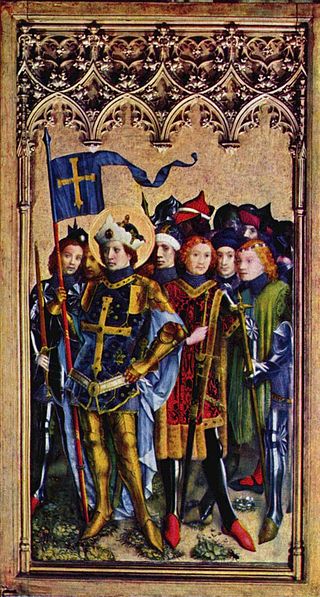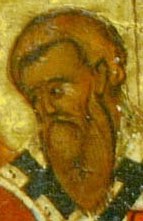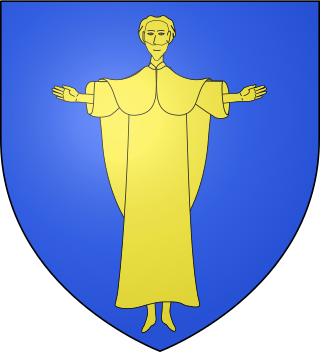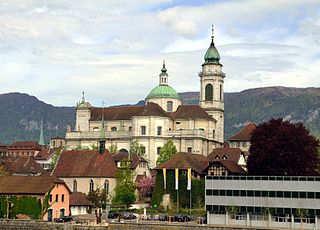
Pope Telesphorus was the bishop of Rome from c. 126 to his death c. 137, during the reigns of Roman Emperors Hadrian and Antoninus Pius.

The Patriarch of Alexandria is the archbishop of Alexandria, Egypt. Historically, this office has included the designation "pope".

Odile of Alsace, also known as Odilia and Ottilia, born c. 662 - c. 720 at Mont Sainte-Odile), is a saint venerated in the Eastern Orthodox Church and the Roman Catholic Church. She is a patroness saint of good eyesight and of the region of Alsace.

The Theban Legion figures in Christian hagiography as a Roman legion from Egypt —"six thousand six hundred and sixty-six men" — consisting of Christian soldiers who were martyred together in 286, according to the hagiographies of Maurice, the chief among the Legion's saints. Their feast day is held on September 22.

Pudens was an early Christian saint and martyr. He is mentioned as a layman of the Roman Church in 2 Timothy 4:21.

Saint Fridolin of Säckingen, also known as Fridold or Fredelinus, is a legendary Irish missionary, apostle of the Alamanni and founder of Säckingen Abbey on the Upper Rhine. He is also the patron saint of the Swiss canton of Glarus.

Saint Novatus is an early Christian saint. His feast day is 20 June.

Manahen was a teacher in the first century Christian Church at Antioch who had been 'brought up' with Herod Antipas.

The Magdeburg Centuries is an ecclesiastical history, divided into thirteen centuries, covering thirteen hundred years, ending in 1298; it was first published from 1559 to 1574. It was compiled by several Lutheran scholars in Magdeburg, known as the Centuriators of Magdeburg. The chief of the Centuriators was Matthias Flacius. Lutheran theologian Werner Elert argued that due to its revolutionary critical method of presenting history, it is the basis of all modern church history. It is said that Baronius undertook his Annales Ecclesiastici purely to oppose the Magdeburg Centuriators.

Pammachius was a Roman senator who is venerated as a saint in the Eastern Orthodox and Roman Catholic Churches. He married Paulina. After her death, he gave himself up to works of charity.

Petronius was bishop of Bologna during the fifth century. He is a patron saint of the city. Born of a noble Roman family, he became a convert to Christianity and subsequently a priest. As bishop of Bologna, he built the Church of Santo Stefano.
Nicomedes was a martyr of unknown era, whose feast is observed 15 September. He was buried in a catacomb on the Via Nomentana near the gate of that name.
Andrew the Scot was the Irish-born student and assistant of Donatus of Fiesole. He served as archdeacon of Fiesole under Bishop Donatus.
Simeon Stylites III was a pillar hermit bearing the same name as Simeon Stylites and Simeon Stylites the Younger.

Andeolus or Andéol is an alleged Christian missionary martyred in Gaul.

Maurice was an Egyptian military leader who headed the legendary Theban Legion of Rome in the 3rd century, and is one of the favourite and most widely venerated saints of that martyred group. He is the patron saint of several professions, locales, and kingdoms.
Immaculate Heart of Mary Church, is a Catholic parish church in Cleveland, Ohio and part of the Diocese of Cleveland. It is a located on Lansing Ave. near East 66th St., in a part of the South Broadway neighborhood previously known as Warszawa, also referred to today as Slavic Village. Both the church and the area are GNIS named features. The church is in the neighborhood of, but not within, the area listed as Warszawa Neighborhood District on the National Register of Historic Places. The church, school, rectory, and convent buildings are listed together as a Cleveland Designated Landmark.
Saint Gallicanus was a Roman martyr in Egypt in 363 AD, during the reign of Julian. A former general, he converted to Christianity and retired to Ostia where he was involved in a variety of charitable works. The Emperor exiled him to Egypt, where he was later martyred.

The St. Ursus Cathedral or Solothurn Cathedral is the cathedral of the Roman Catholic Diocese of Basel in the city of Solothurn, Switzerland. It is a Swiss heritage site of national significance.

St Mary of the Angels is a Roman Catholic church on Moorhouse Road in Bayswater, London, England, within the City of Westminster. The parish it serves is partly in the City of Westminster and partly in the Royal Borough of Kensington and Chelsea.

















